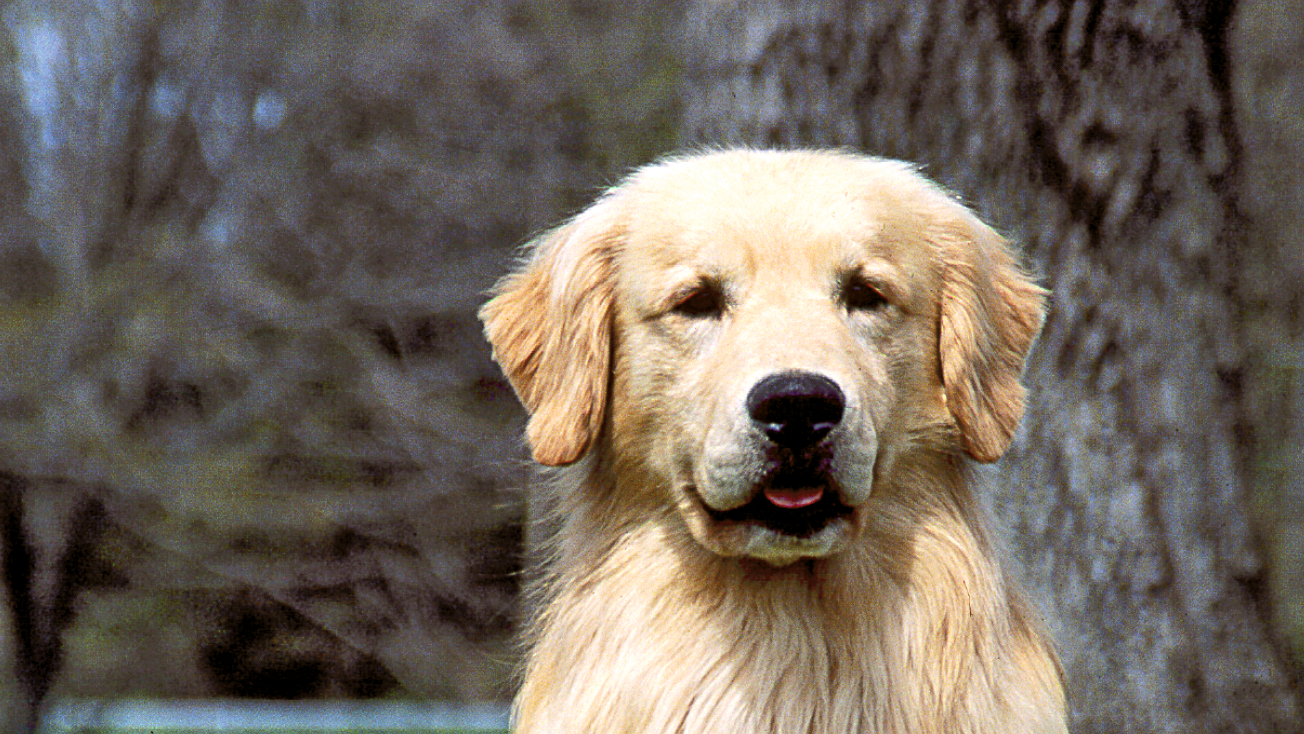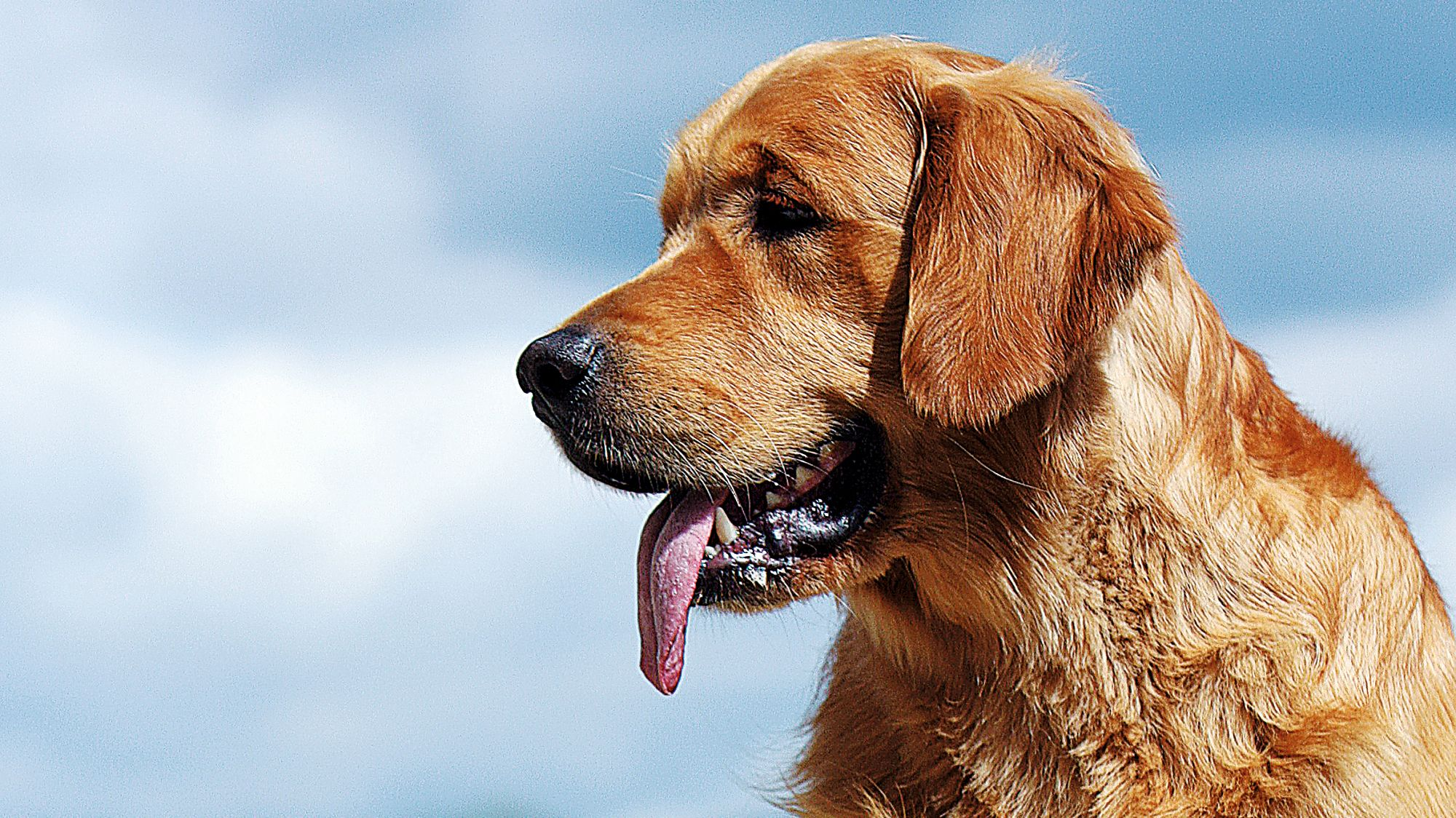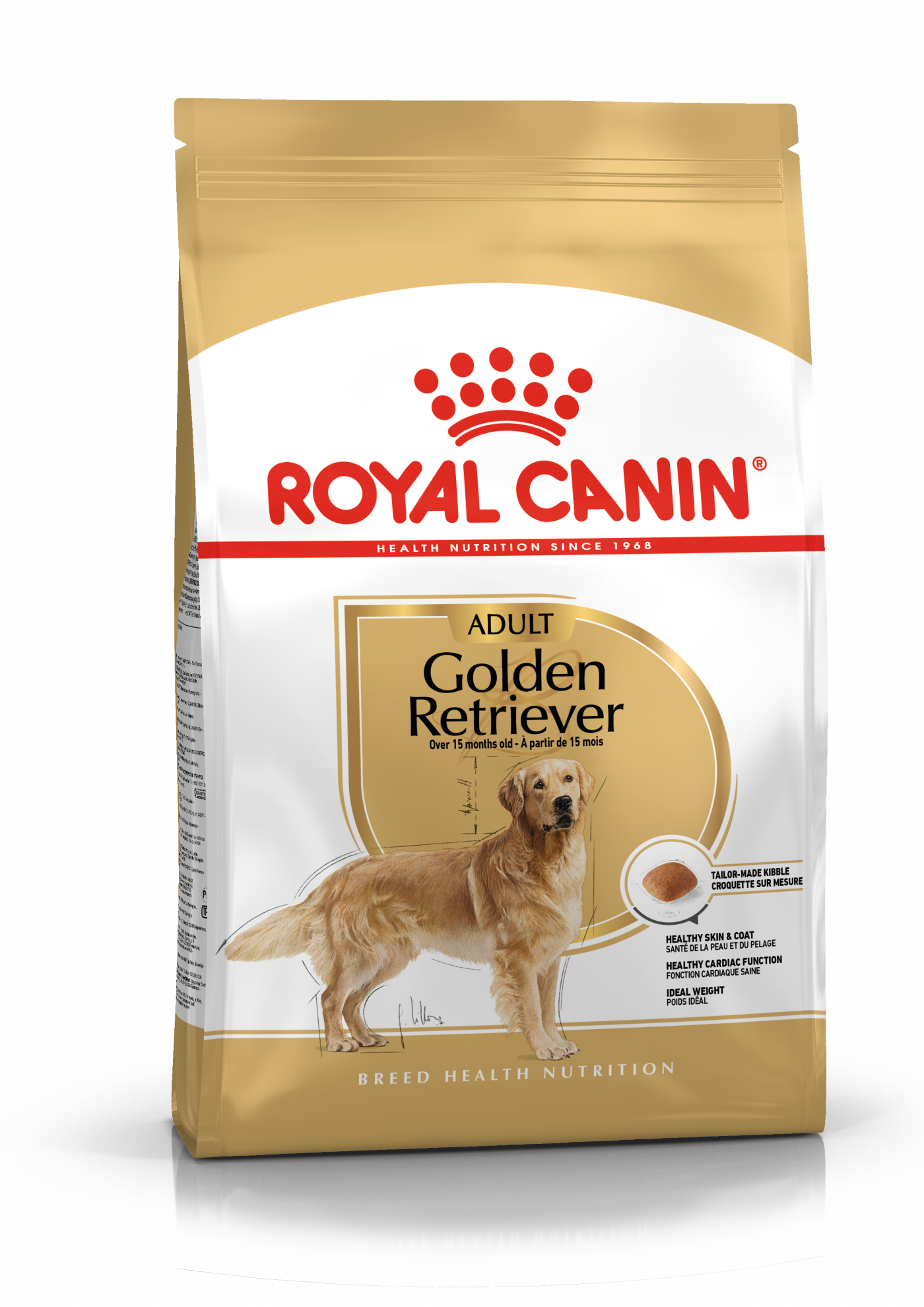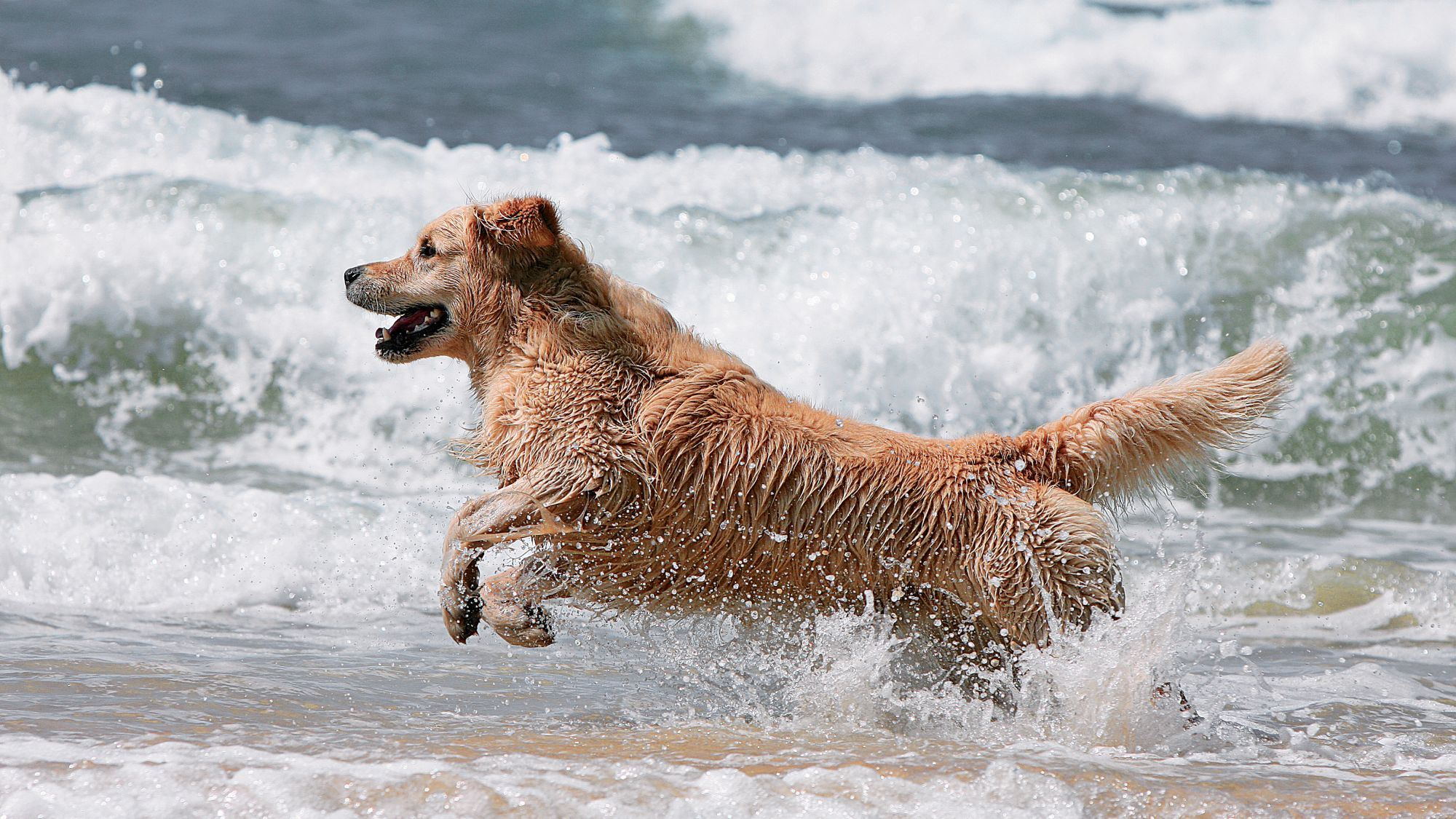Let's talk Golden Retrievers
The very definition of the words “bounding dog”, Golden Retrievers are full of joyful exuberance. They are a very gentle breed and have an excellent temperament. Golden Retrievers are friendly and affectionate to all around them. Golden Retrievers are a remarkably versatile breed, too. With the proper training they can work as guide dogs and are also great companions in the home. When you add in their golden good looks and robust constitution, it’s no surprise they are one of the world’s most popular dogs.
Official name: Golden Retriever
Origins: Scotland
Drooling tendencies
3 out of 5Grooming needs
3 out of 5Shedding Level
4 out of 5Barking tendencies
4 out of 5Energy level*
3 out of 5Compatibility with other pets
4 out of 5Warm weather?
2 out of 5Cold weather?
3 out of 5Suited to apartment living
2 out of 5Can stay alone
2 out of 5Family pet?*
4 out of 5
| Male | Female |
|---|---|
| Height | Height |
| 56 - 61 cm | 51 - 56 cm |
| Weight | Weight |
| 30 - 34 kg | 25 - 30 kg |
| Life Stage | |
|---|---|
| Puppy | Adult |
| 2 to 15 months | 15 months to 5 years |
| Mature | Senior |
| 5 to 8 years | 8 to 18 years |
Drooling tendencies
3 out of 5Grooming needs
3 out of 5Shedding Level
4 out of 5Barking tendencies
4 out of 5Energy level*
3 out of 5Compatibility with other pets
4 out of 5Warm weather?
2 out of 5Cold weather?
3 out of 5Suited to apartment living
2 out of 5Can stay alone
2 out of 5Family pet?*
4 out of 5
| Male | Female |
|---|---|
| Height | Height |
| 56 - 61 cm | 51 - 56 cm |
| Weight | Weight |
| 30 - 34 kg | 25 - 30 kg |
| Life Stage | |
|---|---|
| Puppy | Adult |
| 2 to 15 months | 15 months to 5 years |
| Mature | Senior |
| 5 to 8 years | 8 to 18 years |

Get to know the Golden Retriever
All you need to know about the breed
That said, they are also known for their great sporting & working prowess and excellent tracking abilities. As such, Golden Retrievers are often utilized by search-and-rescue teams in the hunt for missing people. At the same time, their gentle temperament makes them ideal as guide dogs for the blind or visually impaired persons. They also make great therapy dogs.
One thing they definitely aren’t, however, is a watchdog. In fact, they’re more likely to wag their tails at an intruder than anything else!
Most of all, though, Golden Retrievers are perhaps best known as a cherished family pet. Great with children and other animals once trained, they form deep bonds with their human families –and the feeling is mutual. Along with German Shepherds and Labradors, Golden Retrievers are frequently cited as one of the three most popular breeds in the world.
In terms of their appearance, Golden Retrievers have a thick, water-resistant coat with a dense undercoat. This can vary in color from a pale gold to a deeper amber shade and everything in-between. The one constant is that it is very thick, and built to withstand the elements. But this does mean it requires a fair bit of grooming.
Golden Retrievers do need a fairly high level of daily exercise too – whether that’s a walk, a jog or running after a ball. Retriever by name, retriever by nature, they like nothing better than fetching an object and bringing it back to you. So, if you can indulge your Golden Retriever in this, they’ll be your number one fan.

2 facts about the Golden Retriever
1. 101 Retrievers
In July 2006, the Golden Retriever Club of Scotland organized a gathering at the ancestral home of the breed. During the event, a photo was taken – and, with 188 dogs, it is believed to hold the record for the most Golden Retrievers in one picture.
2. A dog's dinner
This is a breed that loves to eat! As a result Golden Retrievers can easily become overweight. It is important, therefore, to keep treats to a minimum and be sure to opt for a high-quality, low-fat food. For more facts on the best diet for the Golden Retriever, see below.
History of the breed
The origins of the Golden Retriever date back 200 years. To discover the breed’s story, we need to head to 19th century Scotland. There, we meet a Scottish aristocrat called Lord Tweedmouth and his Yellow Retriever named Nous.
In 1865, this keen hunter decided that he wanted to create a gundog that could cope with the tough terrain and harsh climate. So, he crossed his Yellow Retriever with the now extinct Tweed Water Spaniel and added the Irish Setter and Bloodhound into mix. As he kept careful notes of his findings, we have the full history of the Golden Retriever.
The early Golden Retrievers were first shown in England in 1908 and recognized by the Kennel Club there in 1911. At that point, however, they were classified as a ‘Retriever – Yellow or Golden’. Following the creation of the Golden Retriever Club, in 1913, the name was changed in line with that. The Golden Retriever was inaugurated by the American Kennel Club in 1925.
Today, they are one of the most popular dog breeds across the world – though, interestingly, there are actually three different types of Golden Retriever: English, Canadian and American. However, as there are only subtle differences between them, they are all classed as the same breed.
From head to tail
Physical characteristics of the Golden Retriever
1.Ears
2.Face
3.Fur
4.Body
5.Tail

Things to look out for
From specific breed traits to a general health overview, here are some interesting facts about your Golden Retriever
Be sure to check their ears regularly
Among the more common health concerns that can affect the Golden Retriever is a condition called ‘otitis’ – otherwise known as ear infections. This is often caused by an allergy and can be painful and itchy for the dog. In more serious cases, it can also result in hearing damage. As a result, ears should be checked weekly for any sign of infection and, in the event of anything unusual, your Golden Retriever should be taken straight to your vet. Professional examinations are also recommended at least twice a year.
They can also experience joint problems
Like a number of other dog breeds, Golden Retrievers have a genetic predisposition to something called hip dysplasia – a condition that results in the loosening of the hip joint. This can lead to pain and inflammation and also result in arthritis later on in the dog’s life. However, the condition can be managed, so have a chat with your vet about the options available. For example, if your Golden Retriever is carrying excess weight, this can magnify the condition, so it’s important that they have a carefully balanced diet. In severe cases, surgery can also be an option.
Be aware of any changes in their body
Unfortunately, Golden Retrievers can also be susceptible to several types of cancer –including lymphoma, hemangiosarcoma and mast cell tumours.
As early detection is key, it’s important to keep an eye out for any unusual symptoms – in-particular any lumps and bumps, obvious pain, or laboured breathing. Your Golden Retriever’s grooming sessions can be a good opportunity to give your dog the once-over. Unfortunately, if an internal organ is affected, it can be much harder to spot. So, if your Golden Retriever seems a bit off-color, refuses to eat or loses weight, take them to see the vet. Comprehensive examinations with your vet are also recommended at least twice a year.
Healthy diet, healthier dog

When choosing food for a Golden Retriever, there are many factors to consider: their age, lifestyle, activity level, physiological condition and health, including potential sickness or sensitivities. Food provides energy to cover a dog’s vital functions and a complete nutritional formula should contain an adjusted balance of nutrients to avoid any deficiency or excess in their diet, both of which could have adverse effects on the dog. Clean and fresh water should be available at all times to support good urinary regularity. In hot weather and especially when out exercising, bring water along and give your dog frequent water breaks.
Energy intake may also need to be adapted to climatic conditions. A dog that lives outdoors in winter will have increased energy requirements. The following recommendations are for healthy animals. If your dog has health problems, please consult your veterinarian, who will prescribe an exclusively veterinary diet.
A Golden Retriever puppy’s requirements, in terms of energy, protein, minerals and vitamins, are much greater than those of an adult dog. They need energy and nutrients to maintain their body, as well as to grow and build new cells. Until they are 15 months old, Golden Retriever puppies’ immune system develops gradually. A complex of antioxidants – including vitamin E – can help support their natural defences during this time of big changes, discoveries and new encounters. Their digestive functions are different from an adult Golden Retriever’s, too: their digestive system is not mature yet, so it's important to provide highly digestible proteins that will be used effectively. Prebiotics, such as fructo-oligosaccharides, support digestive health by helping to balance intestinal flora, resulting in good stool quality.
It is important to choose kibble that is appropriate in shape, size and texture. This growth phase also means moderate energy needs. Large-breed puppies, such as Golden Retriever puppies, whose growth period is long and intense, are especially susceptible to skeletal and joint problems, including limb defects, bone deformities and joint lesions. The first period of growth mainly consists of bone development, although the muscles also start to grow then as well. This means that a puppy that eats too much – takes in too much energy – will put on too much weight and grow too quickly. Limiting the energy concentration of a food for Golden Retriever puppiesand feeding a correct daily amount will help control the speed of growth and minimise these risks.
Concentrations of other nutrients should be higher than normal in a specially formulated growth food. Although the calcium content in the food needs to be increased, maxi-sized breed puppies are more sensitive to excessive calcium intake. It’s important to understand, then, that adding any ingredients to a complete food formulated for the growth phase is at best, unnecessary and at worst, dangerous for the animal, unless prescribed by a veterinarian. Splitting the daily allowance into three meals a day is recommended until they are six months old, after which you should switch to two meals per day.
Throughout their life, it is important to avoid feeding Golden Retrievers human foods or fatty snacks. Instead, reward them with kibble taken from their daily meal allowance and follow the feeding guidelines written on the package strictly, in order to prevent excessive weight gain.
Helping to preserve the health and beauty of the skin and coat with the enriched addition of essential fatty acids (especially EPA-DHA), essential amino acids and B vitamins.

The main nutritional goals for adult Golden Retrievers are:
Maintaining an ideal body weight by using highly digestible ingredients and keeping the fat content at a sensible level
Helping to support the health of their bones and joints with glucosamine, chondroitin and antioxidants

After 5 years old, Golden Retrievers will start facing the first signs of ageing. A formula enriched with antioxidants will help to maintain their vitality, while specific nutrients, such as chondroitin and glucosamine, will help to support healthy bones and joints. Ageing is also accompanied by the modification of digestive capacities and particular nutritional requirements, so food for older Golden Retrievers should have the following characteristics:
Higher vitamin C and E content. These nutrients have antioxidant properties, helping to protect the body’s cells against the harmful effects of the oxidative stress linked to ageing
High-quality protein. Contrary to a widely held misconception, lowering the protein content in food brings little benefit in limiting kidney failure. In addition, older dogs are less efficient at using dietary protein than younger dogs. Reducing the phosphorus content is a good way of slowing down the gradual deterioration of kidney function
A higher proportion of the trace elements iron, zinc and manganese to help to keep the skin and coat in good condition
A higher quantity of polyunsaturated fatty acids to help to maintain the quality of the coat. Dogs can normally produce these fatty acids but ageing can affect this physiological process
As they age, dogs increasingly suffer from teeth problems. To ensure that they continue to eat enough, the shape, size and texture of their kibble needs to be tailored to their jaw.

Caring for your Golden Retriever
Grooming, training and exercise tips
Golden Retrievers require plenty of outdoor exercise, so adult dogs should be getting at least an hour a day – but ideally two or more. If they don’t have enough exercise, Golden Retrievers can become a little bit boisterous, so, a good long walk or run will help them to burn off any excess energy. Conversely, some dogs, given the opportunity, will quite happily turn into couch potatoes, which can lead to weight gain, so exercise is important all-round. Golden Retrievers also enjoy fetching and swimming, so it’s worth being a bit creative with their activity options.
Golden Retriever’s have long coats that require a fair bit of maintenance. Especially as they love nothing better than tearing through muddy fields, rolling in a puddle or enjoying a swim (which, by the way, they are a big fan of). In addition, Golden Retrievers are prone to shedding quite profusely. They should therefore be brushed at least twice a week, and daily during the hot months of summer. Their coat should also be checked after their walks, to make sure nothing is tangled in their fur, and they will need regular baths to keep them smelling sweet. Trimming their nails, checking their ears and brushing their teeth should all be done regularly too.
A smart and intelligent breed, Golden Retrievers are also eager to please – so this makes training a pleasant experience for both dog and owner alike. As they’re also very food-motivated, treats can be an extra enticement – as long as they are healthy ones! Think about taking treats from their daily food portion. Start your Golden Retriever early with regular socialization and puppy-training classes and they’ll soon get the hang of things. Also renowned for their excellence in agility and obedience classes, many go on to excel in the show ring. Your Golden Retriever’s training can also be supported with regular games back at home – another good bonding opportunity.
Golden Retrievers require plenty of outdoor exercise, so adult dogs should be getting at least an hour a day – but ideally two or more. If they don’t have enough exercise, Golden Retrievers can become a little bit boisterous, so, a good long walk or run will help them to burn off any excess energy. Conversely, some dogs, given the opportunity, will quite happily turn into couch potatoes, which can lead to weight gain, so exercise is important all-round. Golden Retrievers also enjoy fetching and swimming, so it’s worth being a bit creative with their activity options.
Golden Retriever’s have long coats that require a fair bit of maintenance. Especially as they love nothing better than tearing through muddy fields, rolling in a puddle or enjoying a swim (which, by the way, they are a big fan of). In addition, Golden Retrievers are prone to shedding quite profusely. They should therefore be brushed at least twice a week, and daily during the hot months of summer. Their coat should also be checked after their walks, to make sure nothing is tangled in their fur, and they will need regular baths to keep them smelling sweet. Trimming their nails, checking their ears and brushing their teeth should all be done regularly too.
A smart and intelligent breed, Golden Retrievers are also eager to please – so this makes training a pleasant experience for both dog and owner alike. As they’re also very food-motivated, treats can be an extra enticement – as long as they are healthy ones! Think about taking treats from their daily food portion. Start your Golden Retriever early with regular socialization and puppy-training classes and they’ll soon get the hang of things. Also renowned for their excellence in agility and obedience classes, many go on to excel in the show ring. Your Golden Retriever’s training can also be supported with regular games back at home – another good bonding opportunity.
All about the Golden Retriever
While it’s true that there is only one breed of Golden Retriever, there are three different sub-types within that: the English, Canadian and American. In general, English Golden Retrievers tend to have a stockier build and a lighter-colored coat than the others. Conversely, Canadian and American Golden Retrievers have a similar frame to each other but Canadians have a thinner coat. And a different accent when they bark, of course.
While Golden Retrievers can cope better than some breeds when left alone, they actually like nothing better than hanging out with their human family. Also, if separated from them for too long or too frequently, separation anxiety can occur – as with any breed. This can lead to barking, howling and destructive behavior. So, in summary, it’s best to leave your Golden Retriever as little as possible. As with any dog, really.
Preparing for your new Golden Retriever puppy

Discover our puppy range
Read more about breeds
Sources
- Veterinary Centers of America https://vcahospitals.com/
- Royal Canin Dog Encyclopaedia. Ed 2010 e 2020
- Banfield Pet Hospital https://www.banfield.com/
- Royal Canin BHN Product Book
- American Kennel Club https://www.akc.org/
Like & share this page